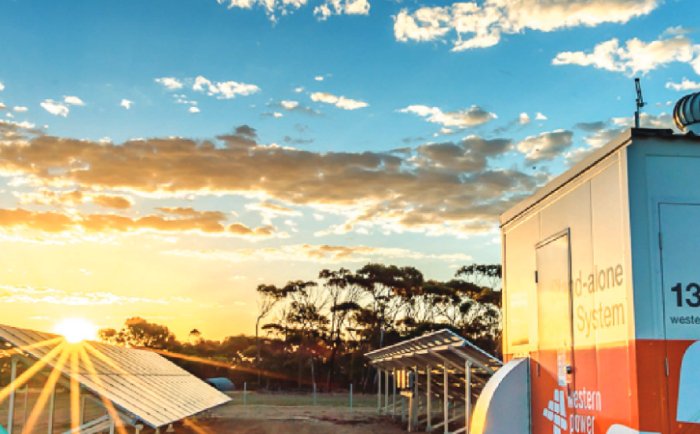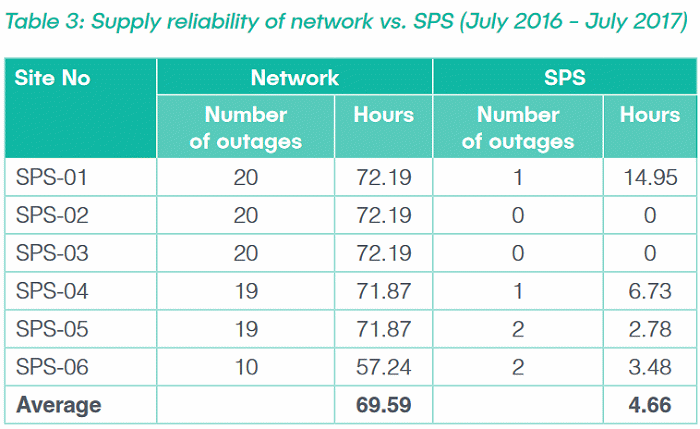
Image credit: Western Power
It’s time to get cracking on microgrids in fringe-of-grid locations across Western Australia says the Clean Energy Council.
In WA, long stretches of powerlines servicing small communities and single properties face ongoing threats from severe weather and bushfires, plus are responsible for significant line loss. These locations these powerlines supply often suffer from poor quality of service, experience regular blackouts and represent a major expense in maintaining services.
Microgrids could supply electricity to these areas more cheaply, safely and reliably than a “poles and wires” approach, while reducing costs associated with network asset replacement and expansion. A microgrid is a local network of electricity generation sources that may include solar power and battery storage. Microgrids are able to operate either interconnected to the mains grid or in “island mode” (disconnected from it).
There have been a number of successful trials of microgrids and stand-alone power systems in Western Australia, and more in the works including the solar-powered Kalbarri Microgrid; but things generally seem stuck in “pilot” phase.
In a submission to WA Economics and Industry Standing Committee, the CEC urges the WA Government to capitalise on its leadership position and move to a more comprehensive microgrid program.
“This could involve undertaking an extensive assessment of where microgrids are expected to provide a superior service, providing opportunities for local businesses, working with distribution networks and establishing a regulatory framework to ensure delivery of agreed standards of reliability and consumer protections,” says the CEC.
Microgrids Could Realise Significant Savings
The CEC’s submission notes Western Power estimates a further potential net benefit of $388 million could be achieved by providing off-grid power supply to 2,702 candidates on its network. An extensive microgrid rollout may also result in cheaper electricity prices for all Western Australians.
Improved Electricity Service Reliability
Western Power’s report – Stand-alone Power System Pilot, One Year On – indicates better than 90% reduction in electricity outage time resulting from a trial at six sites.
Jobs And Investment Opportunities
A major rollout of microgrids in Western Australia could also provide an economic boost through the use of local suppliers for procurement, construction and maintenance of projects.
While uncertainty in policies relating to microgrids may be holding back their deployment in Eastern states, Western Australia being outside the National Electricity Market (NEM) is an advantage that can be used for economic and social benefits for all Western Australians says the CEC.
The Clean Energy Council’s submission can be viewed here (PDF).


 RSS - Posts
RSS - Posts



In this morning’s news …
http://www.abc.net.au/news/2018-04-17/australians-caught-up-in-cyber-attacks-blamed-on-russia/9665820
Bearing in mind what happened in South Australia when an unusual weather event knocked out the entire grid, had there been microgrids in SA the effect would not have been so wide spread as individual micro’s could probably have kept functioning.
And since we’re now being subjected to digital warfare, I’d suggest that microgrids would not only be more difficult to hack, but if there were a successful attack then again the effect would not be so widespread. In the worst case scenario, individual houses with solar panels and batteries could still function, possibly even being able to supply assistance to the community, such as power for electric vehicles.
From the above linked article:
“The United States, Britain and Australia have alleged Russian Government-backed hackers have infected computer routers around the world in a cyber espionage campaign targeting government agencies, businesses and critical infrastructure operators”. Note the last named target – critical infrastructure operators. A major distribution grid does NOT guarantee security of supply.
As WA is pretty well near bankrupt, proper proportional, by population numbers, like federal electoral divisions distributions, distribution of GST revenue, could help bring WA up to scratch, especially, in terms of provision of basic uitilities, essential services, and, infrastructure, all of which are badly inadequate in WA, due to the looting of WA, by state governments and the feral parliament.
With all of the problems experienced in WA, through the electricity grid transmission network, apart from the problems with the generators, it is simply a matter of common sense, to progressively replace the transmission network, with localised electricity provision, and, as WA has the great clean energy sources resources of wind and sunlight, electricity generation and storage, by premises, is simply a matter of common sense.
The big problem, is that the people in power, are so self-absorbed, and, so obsessed with self-interest, that it WA will be forced to remian a backward and underdeveloped region.
And, that is why the NBN that has been forced upon us, has taken telecommunications backward by about seventy to eighty years, so that we do not even have a reasonably reliable telephone network. Who needs emergency services, anyway – the governments have decided that the people of WA, do not need even emergency services. If we can not contact them, in an emrgency, do they really exist?